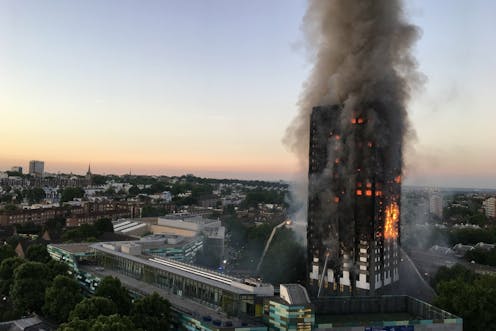
The damning final report from the Grenfell inquiry lays bare the failings that led to the deadly fire. It has been rightly praised for highlighting the “systematic dishonesty” of companies, decades of government failure and the tenant management organisation’s culture of hostility towards residents.
Although broadly well received, there is a glaring omission in the report. It is yet another example of failure to address race and class in the discussion of housing.
The report said the inquiry into the Grenfell disaster has “not brought to light any evidence” that racial or social prejudice played a role in the fire. This absence has been criticised by Grenfell families, who say their questions about race and the fire’s impact specifically on ethnic minority communities were sidelined throughout.
The inquiry did find “some evidence of racial discrimination” after the fire. Namely they highlighted a lack of support for those without English as a first language, and that Muslim survivors observing Ramadan were denied halal food. However, the inquiry makes clear that because this was after the fire, it is not evidence of racism contributing to the disaster.
This claim is surprising when only 11 of the 72 who died in Grenfell Tower (itself named after a colonial British army officer) were white. Especially when academics and lawyers have argued that race, poverty and Grenfell are “inextricably linked”.
Ethnic minorities are disproportionately housed in high-rise social housing. In the case of Grenfell, it meant they were more at risk of the deadly result of flammable cladding.
The decision to leave discussion of social housing allocation, provision and policy out of the inquiry entirely is a striking omission. Grenfell is just one example of how housing (particularly social housing) is affected by structural racism.
What is structural racism in housing?
Structural racism refers to “political and social disadvantages within society” that ethnic minorities experience. It does not mean an aggregation of individual acts of racism. This can make it difficult to demonstrate with evidence and means it is often misunderstood or denied.
But a wealth of research, including our own, shows that access to safe, affordable housing is one area where racial disparities are prevalent. For example, 44% of black African households live in social housing, compared to 16% for white British. Yet, as the Grenfell report shows, these stark inequalities in housing are often described but rarely explained.
The report avoids discussing social housing allocation. Such questions, it argues, are for consideration under the Social Housing (Regulation) Act. But social housing allocation and management played a key role in who lived in Grenfell Tower. Outsourcing these questions to the Social Housing Act (which itself does not mention race or class) suggests that racism is only about whether landlords or other housing authorities have complied with the law.
Racism in housing can be hard to prove, without evidence of direct and intentional racist acts from staff to tenants. But again, to focus on this is to misunderstand structural racism. There do not have to be specific racist incidents to see that the allocation of social housing disproportionately puts certain ethnic groups at a disadvantage.
In England, racialised minorities, especially those who are black, experience more housing disadvantage and homelessness than those who are white. In addition to the statistics about racial disparities in social housing, our freedom of information requests show how people of colour in temporary accommodation are disproportionately housed away from their local area and support networks.
The health and wellbeing of ethnic minorities has also been impacted by estate clearances and poor-quality temporary accommodation. And repeated failures by landlords to address hazards have been seen in the case of Grenfell and beyond.
Want more politics coverage from academic experts? Every week, we bring you informed analysis of developments in government and fact check the claims being made.
Sign up for our weekly politics newsletter, delivered every Friday.
In the wake of Grenfell, the government’s social housing ombudsman has called for social housing providers to reflect on what tenant groups consistently describe as discriminatory relationships. This is because social housing tenants are often stigmatised by their landlords.
Recent statistical analysis has shown that race and ethnicity increase someone’s chance of experiencing homelessness, even when controlling for other socioeconomic factors. However, the complexity of local and national housing systems makes this kind of discrimination hard to respond to. This means policymakers often avoid structural solutions.
We urgently need robust anti-racist housing policy that takes the role of race and class in social housing allocation seriously. Efforts to downplay racism can actually make it worse. By placing this beyond the inquest’s remit, the report’s conclusions feel like a missed opportunity and yet another blow for survivors.
The inquest shows in detail how profit was made from deregulation when it came to the very building materials that killed 72 people. The fact that this repeatedly happens in buildings overwhelmingly housing ethnic minority and working-class people is not a coincidence, it is part of the structure.
Just as with the tragic case of Awaab Ishak, the two-year-old who died after prolonged exposure to mould that was dismissed by his family’s landlord, the Grenfell Tower fire was, quite literally, structural racism.
Nick Clare has received funding from the British Academy
Shaun French is a trustee of the Nottingham Financial Resilience Partnership
Nigel de Noronha does not work for, consult, own shares in or receive funding from any company or organisation that would benefit from this article, and has disclosed no relevant affiliations beyond their academic appointment.
This article was originally published on The Conversation. Read the original article.







